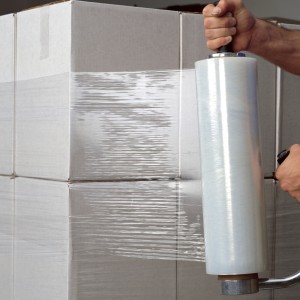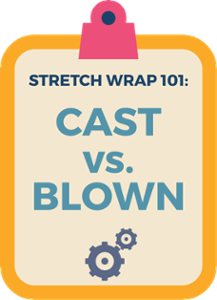
There's a lot of stretch wrap out there...
- Hand stretch
- Machine stretch
- Pre stretched
- Extended Core
- Mini bundling rolls
- Cast stretch
- Blown stretch
- UV, anti-static, colored, etc.
Let's narrow it down to some basic knowledge about hand stretch wrap
Hand stretch wrap can be confusing because it's also referred to as; hand film, hand wrap or manual pallet wrap. It's the most commonly used film and is typically utilized in lower capacity packaging operations. The film is applied manually by hand around the pallet, bet you couldn't guess that one. The operator walks around a pallet and wraps the load securely using the stretch wrap.
Perfect for:
• Wrapping boxes
• Bundling small items
• Pallet wrapping
It's also offered in a many different specialty wraps. Creating stable loads and wrapping them properly, it's possible to recover up to as much as 50% of your potential lost products. Comes in gauges 60-120 and available in sizes: 12", 15", and 18".
Cast vs. Blown
Cast stretch wrap and blown stretch wrap are the two most commonly used types of stretch wraps.
Here are the major differences between the two, as well as the major advantages of each.
CAST STRETCH FILM
Cast stretch wrap is manufactured using a cast extrusion process. The cast extrusion process is a continuous process by which a thermoplastic material is melted and extruded through a flat die onto a chill roll, where it is quenched and re-solidified. Cast stretch wrap has excellent clarity, requires less force to stretch and an increased tear resistance, unwinds quietly from machines, and offers a superior cling.
- Advantages: Generally less expensive than blown stretch wrap, because of reduced manufacturing costs. Increased clarity allows users to see wrapped products. Cast stretch wrap unwinds quietly compared to blown stretch wrap. This type of stretch film offers two sided cling that allows the wrap to stay securely wrapped.
BLOWN STRETCH FILM
Blown stretch wrap is manufactured using the blown extrusion process. Forming a thin walled tube, the melted plastic material is extruded through a die, usually vertically. Air is introduced via a hole in the center of the die like a balloon. On top of the tube an air ring blows onto the stretch film to cool it as it comes off the line. As a result, this process allows blown wrap to be tougher and more resilient than cast stretch wrap. Blown stretch film also typically has a greater load containment force.
- Advantages: Offers higher load and stretch capacity. Blown stretch wrap is a higher quality and has a higher degree of memory once stretched allowing loads to be better secured. A higher tear resistance is an advantage when securing loads with sharp edges.
Key Differences In Hand vs. Machine
Hand Stretch Wrap:
- Stretch film waste
- Up to 10% pre-stretch capacaity
- 12 loads per hour
- Uneven packaging
- Tedious and time consuming
- Manual labor
Machine Stretch Wrap:
- Material savings up to 66%
- Up to 250% pre-stretch capacity
- 55 loads per hour
- Professional packaging
- Quick and easy
- Minimal operator involement



